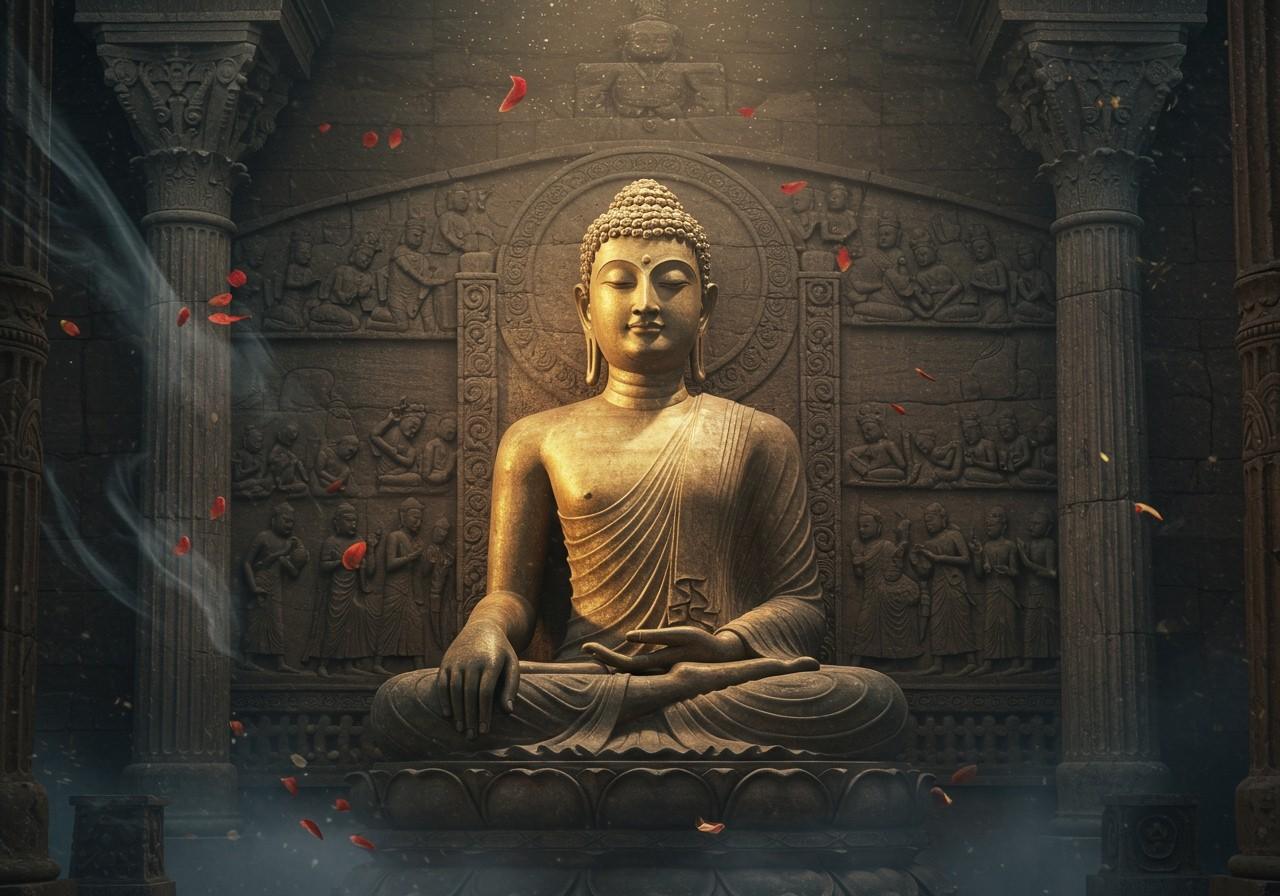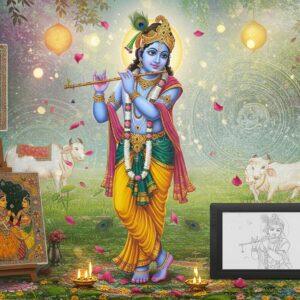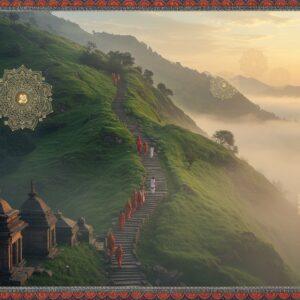Gandhara Art: A Fusion of Greco-Buddhist Cultures

Gandhara art stands as a captivating blend of Greek and Buddhist artistic traditions. Originating in the Gandhara region, now encompassing northwest Pakistan and northeast Afghanistan, this distinctive art form thrived for nearly a millennium, from the 1st century BCE to the 5th century CE, profoundly impacting India’s cultural heritage.
What is Gandhara Art?
Gandhara art is celebrated for its unique style, seamlessly merging Greek and Buddhist elements. The Gandhara region, a historical crossroads of cultures, facilitated this fusion. This art form blossomed during a pivotal period, primarily between the 1st century BCE and the 5th century CE, coinciding with significant historical events and cultural exchanges.
Key Features of Gandhara Art:
- Geographical Region: Gandhara, located in present-day northwest Pakistan and northeast Afghanistan, served as the cradle of this unique artistic tradition.
- Historical Timeline: Flourishing between the 1st century BCE and the 5th century CE, Gandhara art witnessed the rise and fall of empires and the spread of Buddhism across Asia.
- Materials Used: Stone, stucco, and bronze were the primary materials employed by Gandhara artists, showcasing their mastery of diverse mediums.
- Themes: Buddhist imagery, including scenes from the life of Buddha and Jataka tales, formed the core thematic content of Gandhara art, reflecting the profound influence of Buddhist philosophy.
- Motifs: Representations of Buddha, Bodhisattvas, and other mythological figures populated the artistic landscape of Gandhara, adding a rich layer of symbolism and religious significance.
What is the Gandhara Art Style?
The Gandhara art style is instantly recognizable for its syncretic nature, harmoniously blending Greek and Buddhist aesthetics. Employing Greco-Roman artistic techniques, it portrays realistic human forms, flowing drapery, and lifelike expressions. This style predominantly showcases scenes from the Buddha’s life and other Buddhist narratives.
Notable Features:
- Realistic Human Forms: Drawing inspiration from Greco-Roman art, Gandhara sculptures depict human figures with remarkable realism, capturing anatomical details and natural poses.
- Buddhist Themes: The life of Buddha, Jataka tales, and other Buddhist narratives form the central themes of Gandhara art, providing visual representations of key religious concepts and stories.
- Architectural Contributions: Gandhara art extended its influence to architecture, with stupas and monasteries adorned with intricate carvings, showcasing the artistic skill and devotion of the period.
- Influence: Gandhara art played a pivotal role in disseminating Buddhist art across Asia, leaving a lasting legacy on artistic traditions in various regions.
Who Developed Gandhara Art?
Gandhara art emerged through the collaborative efforts of diverse cultures and individuals. The Indo-Greek kingdoms played a crucial role in merging Greek and Buddhist traditions. The Kushan Empire, particularly under the patronage of King Kanishka, actively promoted Gandhara art and Buddhism.
Key Contributors:
- Indo-Greek Kingdoms: The Indo-Greek kingdoms fostered cultural exchange, creating a fertile ground for the fusion of Greek and Buddhist artistic elements.
- Kushan Empire: The Kushan Empire, under the reign of King Kanishka, became a major patron of Gandhara art, facilitating its widespread development and dissemination.
- Local Artisans: Skilled local artisans played a vital role in bringing Gandhara art to life, creating intricate sculptures and reliefs that embody the unique style of the region.
- Buddhist Monks: Buddhist monks played a crucial role in spreading the religious significance of Gandhara art, contributing to its widespread adoption and integration into Buddhist practice.
Cultural Significance of Gandhara Art
Gandhara art holds immense cultural and religious significance. It was instrumental in the propagation of Buddhism throughout Asia, particularly during the Kushan era when Mahayana Buddhism entered China via the Silk Road. This artistic tradition continues to be celebrated in museums worldwide, serving as a testament to its enduring legacy.
Influence on Modern Culture:
- Museum Exhibits: Gandhara art is prominently displayed in museums globally, offering audiences a glimpse into this remarkable fusion of cultures and artistic styles. Explore ancient temples and artifacts at Poojn.in.
- Contemporary Appreciation: Artists, scholars, and art enthusiasts continue to admire and study Gandhara art, recognizing its historical importance and artistic merit. Find exquisite pieces inspired by ancient traditions at Poojn.in.
- Artistic Influence: Gandhara art has left an indelible mark on Indian and Central Asian artistic traditions, influencing subsequent artistic styles and iconography.
- Modern Buddhist Practice: The symbolic representations found in Gandhara art continue to hold significance in modern Buddhist practices, serving as visual reminders of core beliefs and values. Find authentic puja items at Poojn.in.
FAQs on Gandhara Art
What is Gandhara art? Gandhara art is a unique fusion of Greco-Roman artistic techniques and Buddhist themes, originating in the Gandhara region (modern-day northwest Pakistan and northeast Afghanistan).
What characterizes the Gandhara art style? The Gandhara style blends classical Greek and Roman artistic elements with Buddhist imagery. It features realistic human forms, draped clothing, intricate details, and serene expressions.
Who were the key contributors to Gandhara art? The Indo-Greek kingdoms, the Kushan Empire (especially King Kanishka), local artisans, and Buddhist monks all contributed to the development and spread of Gandhara art.
Why is Gandhara art historically significant? Gandhara art stands as a testament to cultural exchange and fusion, demonstrating the interplay of different civilizations and the spread of Buddhism.
When did Gandhara art flourish? Gandhara art primarily flourished between the 1st century BCE and the 5th century CE, particularly under Kushan rule.
What materials were commonly used in Gandhara art? Stone, stucco, terracotta, and bronze were among the materials used by Gandhara artists.
What subjects are typically depicted in Gandhara art? The Buddha, Bodhisattvas, scenes from the Buddha’s life, and Jataka tales are common subjects in Gandhara art.
Where can Gandhara art be viewed today? Gandhara art can be found in museums worldwide, including those in Pakistan, India, Europe, and the United States. Some archaeological sites in the Gandhara region also house remnants of this historical art form.
Gandhara art is not merely a relic of the past; it continues to resonate with and inspire contemporary artistic expressions and Buddhist practices. Its unique fusion of Eastern and Western elements serves as a powerful reminder of the rich cultural exchanges that have shaped human civilization. By exploring and appreciating Gandhara art, we gain a deeper understanding of our shared heritage and the enduring power of artistic expression.


